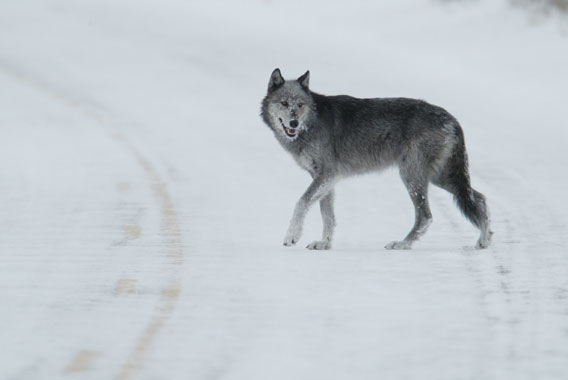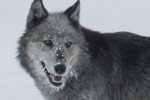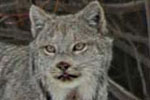
Wolf in Yellowstone National Park. Photo courtesy of Yellowstone National Park.
Less than a year after being pulled off the Endangered Species Act (ESA), gray wolves (Canis lupus) in the western U.S. are facing an onslaught of hunting. The hunting season for wolves has just closed in Montana with 160 individuals killed, around 75 percent of 220-wolf kill quota for the state. In neighboring Idaho, where 318 wolves have been killed so far by hunters and trappers, the season extends until June. In other states—Oregon, Washington, California, and Utah—wolf hunting is not currently allowed, and the species is still under federal protection in Wyoming.
In Idaho fourteen wolves were also killed by the government using helicopters in a bid to prop up elk herds. Legislators in the state are also mulling a recent proposal to allow aerial hunting and the use of live bait to kill wolves that have harassed livestock or pets. Republican and sheep rancher Jeff Siddoway, who introduced the legislation, said he would have no problem using his dog as live bait.
Wolves are hugely controversial in the region: ranchers point to them as a cause for livestock mortalities, while hunters blame them for a decline in elk. Biologists, however, say the elk decline may be due to a combination of drought, hunting by people, and the return of wolves. By nature wolves prey on young, old, and weak animals, and likely have little overall impact on a healthy herd.
In fact, a recent study study in Montana’s Bitterroot Mountains found that wolves were not a primary driver behind elk mortalities. Examining 36 elk calf kills, the study determined that mountain lions were responsible for thirteen (36 percent), black bears killed four (11 percent), wolves also killed four (11 percent), five died of natural causes (13 percent), and ten mortalities were due to unknown causes (27 percent).
However, as top predators, wolves have a big impact on elk and other prey’s behavior, which results in massive implications for the health of an ecosystem. Long-term studies in Yellowstone National Park have recorded notable changes since the return of wolves after a 70-year absence. The findings have shown that wolves are key to a healthy, diverse ecosystem.
Research has found that by keeping elk on the run and in hiding, wolves protect plants and trees that had long been over-browsed, saving some species from local extinction. The presence of wolves allowed trees to grow up along rivers for the first time in decades in Yellostone, protecting against erosion and cooling rivers through shade. In turn, the riverside trees allowed for the return of beavers, which had nearly vanished from Yellowstone. Through dam-building beavers created new habitat for fish. With more trees and shrub cover, songbird populations rose. Scavengers from bear to ravens were aided by wolf-kills. In all, biodiversity and wildlife abundance blossomed.
Less than 2,000 wolves are currently found in seven states of the western U.S., the bulk of them in Montana, Idaho, and Wyoming. California has only one. By contrast 3,000 wolves are found in northern Minnesota alone.

Many top predators worldwide remain hated and feared. Photo courtesy of the National Park Service.
Related articles
Decline in top predators and megafauna ‘humankind’s most pervasive influence on nature’

(07/14/2011) Worldwide wolf populations have dropped around 99 percent from historic populations. Lion populations have fallen from 450,000 to 20,000 in 50 years. Three subspecies of tiger went extinct in the 20th Century. Overfishing and finning has cut some shark populations down by 90 percent in just a few decades. Though humpback whales have rebounded since whaling was banned, they are still far from historic numbers. While some humans have mourned such statistics as an aesthetic loss, scientists now say these declines have a far greater impact on humans than just the vanishing of iconic animals. The almost wholesale destruction of top predators—such as sharks, wolves, and big cats—has drastically altered the world’s ecosystems, according to a new review study in Science. Although researchers have long known that the decline of animals at the top of food chain, including big herbivores and omnivores, affects ecosystems through what is known as ‘trophic cascade’, studies over the past few decades are only beginning to reveal the extent to which these animals maintain healthy environments, preserve biodiversity, and improve nature’s productivity.
(04/17/2011) A ‘rider’ attached to the most recent budget passed this week in the US congress has stripped gray wolves from the protection of the Endangered Species Act, a first in the law’s nearly 40-year-history. The rider, which was signed into law under the budget on Friday by US President Barack Obama, hands gray wolves (Canis lupus) in Montana, Idaho, Utah, Washington, and Oregon from Federal protection to state control. Hunting is expected to begin soon.
The heroic wolf: are wolves the key to saving the Canada lynx?

(08/31/2011) In 2000 the Canada lynx (Lynx canadensis) was listed as threatened under the US Endangered Species Act (ESA). While remaining stable in Canada and Alaska, the Canada lynx population had essentially collapsed in much of the continental US, excluding Alaska. Aside from habitat loss, one of the main factors imperiling the medium-sized wild cat was a decline in prey, specifically snowshoe hares (Lepus americanus). Researchers have now come up with an innovative way to aid hungry lynx in the US: wolves.
What do wolves and sharks have in common?

(11/15/2010) Sharks dwell in the ocean, wolves on land; sharks are a type of fish, wolves are a mammal; sharks go back some 400 million years, wolves only some 2 million years. So, these animals should have little in common, right? However, a new study in Frontiers in Ecology and the Environment points to surprising similarities among these disparate animals. As top predators, both wolves and sharks impact their prey and other species in similar ways.
Why top predators matter: an in-depth look at new research
(02/02/2010) Few species have faced such vitriolic hatred from humans as the world’s top predators. Considered by many as pests—often as dangerous—they have been gunned down, poisoned, speared, ‘finned’, and decimated across their habitats. Even where large areas of habitat are protected, the one thing that is often missing are top predators. However, new research over the past few decades is showing just how vital these predators are to ecosystems. Biologists have long known that predators control populations of prey animals, but new studies show that they may do much more. From controlling smaller predators to protecting river banks from erosion to providing nutrient hotspots, it appears that top predators are indispensible to a working ecosystem. Top predators sit at the apex of an ecosystem’s food chain. Wolves in Alaska, tigers in Siberia, lions in Kenya, white sharks in the Pacific are all examples of top predators.
